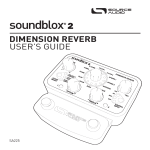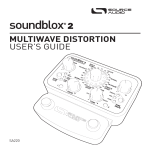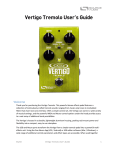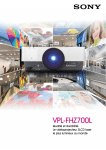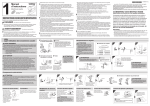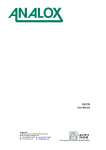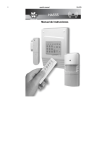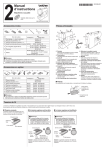Download EffEcTS TROubLESHOOTING SPEcIfIcATIONS
Transcript
Quick Start Controls 1. POWER To power the unit, insert 4 AA batteries (included) or connect a Source Audio 9V power supply to the 9V DC jack (A). EFFECT The effect knob selects the type of filter to be used. See the effect types section for more details. The effect knob also allows you to select the CALIBRATE mode for calibrating the signals from a Hot Hand sensor. See the Use with Hot Hand section for details. 2. GUITAR/AUDIO CONNECTIONS Next, plug your guitar (or other instrument) into the jack labeled GUITAR IN (B) via a standard ¼-inch cable. Connect your amp (or other audio device) to the GUITAR OUT (C) jack, again with a standard ¼-inch cable. Both input and output are mono signals. 4. BRIEF KNOB AND PEDAL DESCRIPTIONS (see Controls section for more details) • EFFECT selects desired filter type. • FREQUENCY adjusts the center frequency of the filter. • SWEEP RANGE adjusts the direction (up/down) and breadth of the filter sweep or the depth of the Hot Hand modulation. • SPEED controls the attack and decay speed of the envelope follower or the motion-sensitivity of the Hot Hand. • ON/OFF engages and disengages the effect. In calibrate mode, the ON/OFF switch starts the calibration. FREQUENCY FREQUENCY The frequency knob sets the center frequency of the filter sweep. Turning the knob counterclockwise will result in the filter moving over lower frequencies for a darker sound. Turning the knob clockwise will result in the filter sweep moving over higher frequencies, which will create a brighter and thinner sound. MIN MIN DOWN UP HH MAX SWEEP RANGE A B C FAST DECAY ATTACK & DECAY SLOW HH SPEED SLOW PICK HH MOTION MAX D FAST FLAIL Note: The unit will not power up until a ¼-inch plug is inserted into the guitar input. This is to conserve power when the unit is running on batteries. Don’t forget to unplug the cable from the input when the unit is not in use— otherwise the batteries will continue to drain. 3. SENSOR IN (optional) To use your Guitar Envelope Filter with a Hot Hand sensor: Connect the sensor to the SENSOR IN (D) jack and follow any instructions supplied with the sensor. you turn the knob to the left. With the Hot Hand controller plugged in, the knob controls the positive or negative depth of the sweep. SWEEP RANGE The sweep range knob controls the direction and breadth of the filter sweep. To the right side of the knob, marked as UP, the filter will move in a positive sweep from low to high with greater range as you turn the knob further to the right. To the left side of the knob, marked as DOWN, the filter will move in a negative sweep from high to low with increased range as SPEED The speed knob controls the attack and decay time of the envelope follower. The range of the speed control is divided into two parts. To the left of the midpoint (12 o’clock) both the attack and release times of the envelope detector are controlled together. They range from slow when fully turned to the left, to fast when set toward the midpoint. As the knob is turned to the right past the midpoint, the attack is fixed at the fastest setting while the decay time gets slower. In Hot Hand mode, the knob controls the response of the motion sensor. FLAIL being the slowest and PICK being the fastest response. See the Use with Hot Hand section for more details. Note: The envelope follower signal can be reset to zero by a very brief moment of silence, allowing the next note played to experience the full sweep of the envelope all the way from zero. ON/OFF The ON/OFF switch engages or disengages the effect. When the effect is engaged, the ON/OFF LED will be lit. The LED will be off in bypass mode. The ON/OFF switch is also used to start the calibration routine when the EFFECT knob is set to CALIBRATE. EffecTS 4 POLE FILTERS Here are some brief technical descriptions of the filter effects included in the Guitar Envelope Filter. Some of the filter types are intended to approximate, but not exactly copy, some common and well-known envelope filter effects. 4 POLE 10 LOW PASS 09 08 11 12 07 13 14 TRIPLE 15 PEAK 16 06 17 05 18 PEAK & 19 NOTCH 20 21 PHASERS 04 2 POLE 03 LOW PASS SINGLE PEAK 02 01 CALIBRATE EFFECT 2 POLE FILTERS 08: Resonant four pole low pass. Like the two pole low pass, but after the resonant peak, the signal falls at 24 dB/octave. 09: Four pole low pass with two resonant peaks. The resonant peaks are separated by 1.3 octaves. 10: Peak, Four pole low pass. A four pole low pass with an extra peak at a lower frequency than the resonant peak. 11: Four pole low pass, peak. A four pole low pass with an extra peak at a higher frequency than the resonant peak. SINGLE PEAK 12: Peak. The frequency response is flat, except in the region around the peak. Moderate Q. 13: Peak. As above, with higher Q. 01: Resonant low pass. A flat response at low frequencies, rising to a resonant peak, and then falling at 12 dB/octave. Low resonance (low Q). TRIPLE PEAKS 02: Resonant low pass. High resonance (high Q). 16, 17: Three peaks moving in opposing directions. 03: Notch, Resonant low pass. The frequency response begins flat, then has a deep notch, then back to flat, and then a resonant peak followed by a 12 dB/octave fall. 04: Notch, Notch, Resonant low pass. Same as 03, but with two notches. 05: Peak, Notch, Resonant low pass. A resonant peak, followed by a notch, followed by a resonant low pass. 06: Resonant low pass, Peak, Peak. As the response of the low pass filter falls, the fall is interrupted by two peaks. The low pass resonant peak moves in the opposite direction from the additional higher frequency peaks. Specifications Dimensions • L: 7 inches • W: 4 inches • H: 2 inches (including knobs) Weight • 1.25lbs Power • 125mA @ 9V DC (max 145mA with Hot Hand Wireless Adapter) • 15-20 hours battery life • NEGATIVE tip power jack Audio Performance • 115dB DNR audio ADC • 24-bit audio conversion • 56-bit digital data path • Analog bypass Troubleshooting Noise: Low Power Change batteries or plug in a DC power supply. Near noise source Move pedal away from power supplies and other equipment. Other equipment Remove other effects from signal chain, see if noise persists. Bad cables Swap out audio cables. 14, 15: Three peaks moving together. PEAKS AND NOTCHES 18: Peak, Notch, Peak. 19: Notch, Peak, Notch. Low volume: Low power Change batteries or plug in a DC power supply. Hot Hand doesn’t work: Low power Change batteries or plug in a DC power supply. Not calibrated properly Calibrate the Hot Hand (see Use with Hot Hand). Not connected Check Hot Hand connections. PHASERS Knobs don’t work /light up: 20: Notch, Notch. A pair of frequency response notches creates a standard two notch phaser. There is a little feedback to boost the non-notched frequencies. Low power Change batteries or plug in a DC power supply. Wrong power supply Use correct power supply (see Quick Start). Corroded input cable plug Check input cable plug for corrosion on sleeve, swap out cable if necessary. TRS (stereo) cable used Only use mono cable for input cable. 21: Notch, Notch, Notch. A three notch phaser with some feedback. For additional assistance, please visit www.sourceaudio.net 07: Two resonant low pass filters in parallel. If possible, dispose of the device at a recycling centre. Do not dispose of the device with the household waste. Source Audio, LLC (hereinafter “Source Audio”) warrants that your new Source Audio Soundblox Effects Pedal, when purchased at an authorized Source Audio dealer in the United States of America (“USA”), shall be free from defects in materials and workmanship under normal use for a period of one (1) year from the date of purchase by the original purchaser. This Limited Warranty does not extend to the batteries which are purchased as is. Please contact your dealer for information on warranty and service outside of the USA. Under this Limited Warranty, Source Audio’s sole obligation and the purchaser’s sole remedy shall be repair, replacement, or upgrade, at Source Audio’s sole discretion, of any product that, if properly used and maintained, proves to be defective upon inspection by Source Audio. Source Audio reserves the right to update any unit returned for repair and to change or to improve the design of the product at any time without notice. Source Audio reserves the right to use reconditioned parts and assemblies as warranty replacements for authorized repairs. Any product repaired, replaced, or upgraded pursuant to this Limited Warranty will be warranted for the remainder of the original warranty period. This Limited Warranty is extended to the original retail purchaser. This Limited Warranty can be transferred to anyone who may subsequently purchase this product provided that such transfer is made within the applicable warranty period and Source Audio is provided with all of the following information: (i) all warranty registration information (as set forth on the registration card) for the new owner, (ii) proof of the transfer, within thirty (30) days of the transfer, and (iii) a photocopy of the original sales receipt. Warranty coverage shall be determined by Source Audio in its sole discretion. This is your sole warranty. Source Audio does not authorize any third party, including any dealer or sales representative, to assume any liability on behalf of Source Audio or to make any warranty on behalf of Source Audio. WARRANTY INFORMATION Source Audio may, at its option, require proof of the original purchase date in the form of a dated copy of original authorized dealer’s invoice or sales receipt. Service and repairs of Source Audio products are to be performed only at the Source Audio factory or a Source Audio authorized service center. Prior to service or repair under this Limited Warranty, the purchaser must request from Source Audio a return authorization, which is available at: Source Audio LLC 120 Cummings Park, Woburn, MA 01801 (781) 932-8080 or at www.sourceaudio.net. Unauthorized service, repair, or modification will void this Limited Warranty. DISCLAIMER AND LIMITATION OF WARRANTY DO NOT OPEN THE EFFECTS PEDAL UNDER ANY CIRCUMSTANCE. THIS WILL VOID THE WARRANTY. THE FOREGOING LIMITED WARRANTY IS THE ONLY WARRANTY GIVEN BY SOURCE AUDIO AND IS IN LIEU OF ALL OTHER WARRANTIES. ALL IMPLIED WARRANTIES, INCLUDING WARRANTIES OF MERCHANTABILITY AND FITNESS FOR ANY PARTICULAR PURPOSE, EXCEEDING THE SPECIFIC PROVISIONS OF THIS LIMITED WARRANTY ARE HEREBY DISCLAIMED AND EXCLUDED FROM THIS LIMITED WARRANTY. UPON EXPIRATION OF THE APPLICABLE EXPRESS WARRANTY PERIOD, SOURCE AUDIO SHALL HAVE NO FURTHER WARRANTY OBLIGATION OF ANY KIND, EXPRESS OR IMPLIED. SOURCE AUDIO SHALL IN NO EVENT BE LIABLE FOR ANY SPECIAL, INCIDENTAL OR CONSEQUENTIAL DAMAGES SUFFERED BY THE PURCHASER OR ANY THIRD PARTY, INCLUDING WITHOUT LIMITATION, DAMAGES FOR LOSS OF PROFITS OR BUSINESS OR DAMAGES RESULTING FROM USE OR PERFORMANCE OF THE PRODUCT, WHETHER IN CONTRACT OR IN TORT. SOURCE AUDIO SHALL NOT BE LIABLE FOR ANY EXPENSES, CLAIMS OR SUITS ARISING OUT OF OR RELATING TO ANY OF THE FOREGOING. Some states do not allow the exclusion or limitation of implied warranties so some of the above limitations and exclusions may not apply to you. This Limited Warranty gives you specific legal rights, and you may also have other rights, which vary, from state to state. This Limited Warranty only applies to products sold and used in the USA. Source Audio shall not be liable for damages or loss resulting from the negligent or intentional acts of the shipper or its contracted affiliates. You should contact the shipper for proper claims procedures in the event of damage or loss resulting from shipment. © SOURCE AUDIO LLC 120 CUMMINGS PARK, WOBURN, MA 01801 SOURCEAUDIO.NET The Soundblox Guitar Envelope Filter is a new type of envelope filter effect. The unit features multiple filter types ranging from classic to modern and beyond which are all controlled by a flexible envelope follower. An envelope follower is an algorithm that responds to the amplitude (or volume) of the incoming signal and creates a control signal based on the input level. This control signal is used to “move” or modulate the filter to create a wah-like effect. Additionally, the filter effects can be controlled by a Hot Hand Motion Sensor. Either a wired or wireless sensor can be plugged into the sensor input on the back panel. When a sensor is plugged in, the unit goes into “Hot Hand Mode” and the controls take on slightly different functions. Also, the calibrate feature is intended for use with the “Hot Hand Mode” only. Hot Hand REady While the primary function of the Guitar Envelope Filter is as a standalone effect pedal you also have the option of exploring some additional functions by plugging in a Hot Hand sensor. When a sensor is plugged in the unit goes into Hot Hand mode. In Hot Hand mode, the controls take on some secondary functions. These are shown by the white text beneath main label of the knobs. Hot Hand Basics The Hot Hand motion sensors are sold separately and come in either wired or wireless versions. Both will work with the Guitar Envelope Filter. Additionally, the SENSOR IN jack will be compatible with any future Source Audio sensors. The Hot Hand ring contains an accelerometer that responds to acceleration and is not based on any type of proximity to the guitar. By moving your hand or by changing the position of your hand you can modulate the effect. For a good description of Hot Hand Theory, download the Hot Hand Motion Controlled Wah Filters manual. It is available at www.sourceaudio.net. Keep in mind that the Guitar Envelope Filter can only use the x-axis of the ring sensor. y x GUITAR Envelope Use with Hot Hand x y Filter Depth In Hot Hand mode, the SWEEP RANGE knob becomes the depth of the effect based on the sensor input. It can alternatively be thought of as a gain control for the Hot Hand signal. Increasing the depth will cause the filter to move more based on smaller motions of the sensor. Decreasing the depth will decrease the movement of the filter. In Hot Hand mode, the depth increases turning the knob to the left or right except that in the ‘+’ region the motion of the filter will be from low to high and in the ‘-‘ region the filter will move from high to low. This effectively inverts the Hot Hand signals. Calibration The Guitar Envelope Filter has a calibration feature which is only used in Hot Hand mode. However, calibration is not required before use. The calibration feature allows you to set the midpoint of the filter sweep for any position of your hand. Depending on your playing style, you may find it useful to try some different calibration positions. The most common use of calibration is setting your resting hand position on the guitar to be the midpoint of the filter sweep. Calibration can also be useful if you are putting the sensor on a headband or other alternate locations. To perform a calibration Motion Control The SPEED control becomes the MOTION control in Hot Hand mode and is used to smooth out the input from the sensor by filtering out fast changes in the signals. The amount of smoothing is controlled by the knob. Turning the knob towards FLAIL provides the most amount of smoothing and the effect will now only react to large, slow motions of the sensor. This is useful when you only want the effect to respond to large, deliberate motions. Turning the knob all the way to PICK sets the smoothing at a minimum. This means that fast changes in the sensor signal will be applied to the effect. The motions created from normal picking will be enough to move the filter. This may cause the sound to be too “jittery”, in which case, turn the knob towards STRUM and FLAIL to get the desired response. The STRUM setting is a nice compromise that allows some moderately fast motions through without being too jittery. • T urn the EFFECT knob to the CALIBRATE position. • H old the sensor in the desired position. • W hile holding the sensor steady, press the ON/OFF footswitch and wait for 1 second. • T urn the EFFECT knob away from calibrate to use your new calibration setting. Note: Calibration settings will be saved between power cycles. If you have trouble with calibration and need to get back to the default setting, place the sensor on a flat, level surface with the blue LED facing down and run the calibration procedure again. USERS GUIDE Thank you for purchasing a Soundblox Guitar Envelope Filter. The Guitar Envelope Filter is a highly flexible envelope filter effect specially optimized for the guitar. With 21 filter types and a variety of control options, the Guitar Envelope Filter can create a wide range of envelope filter sounds from traditional filter effects to unique advanced filter sounds. Enjoy! The Source Audio team •DIVERSE SOUND PALETTE Featuring 21 types of envelope filter and phaser effects. •FLEXIBLE ENVELOPE CONTROL A simple but powerful control set makes it easy to dial in your desired envelope response. • MODERN DESIGN A thoughtfully designed box which features rugged construction and sleek looks. • STATE-OF-THE-ART DSP Our proprietary 56-bit Digital Signal Processor, the SA601, and crystal clear 24-bit converters. • MOTION CONTROL All Soundblox pedals are “Hot Hand Ready” and can be used with any Hot Hand motion sensor to extend the capabilities of the unit. • ACTIVE ANALOG BYPASS Bypass is fully routed around the DSP and active input ensures zero signal degradation. SA127 ® Features LIMITED WARRANTY


